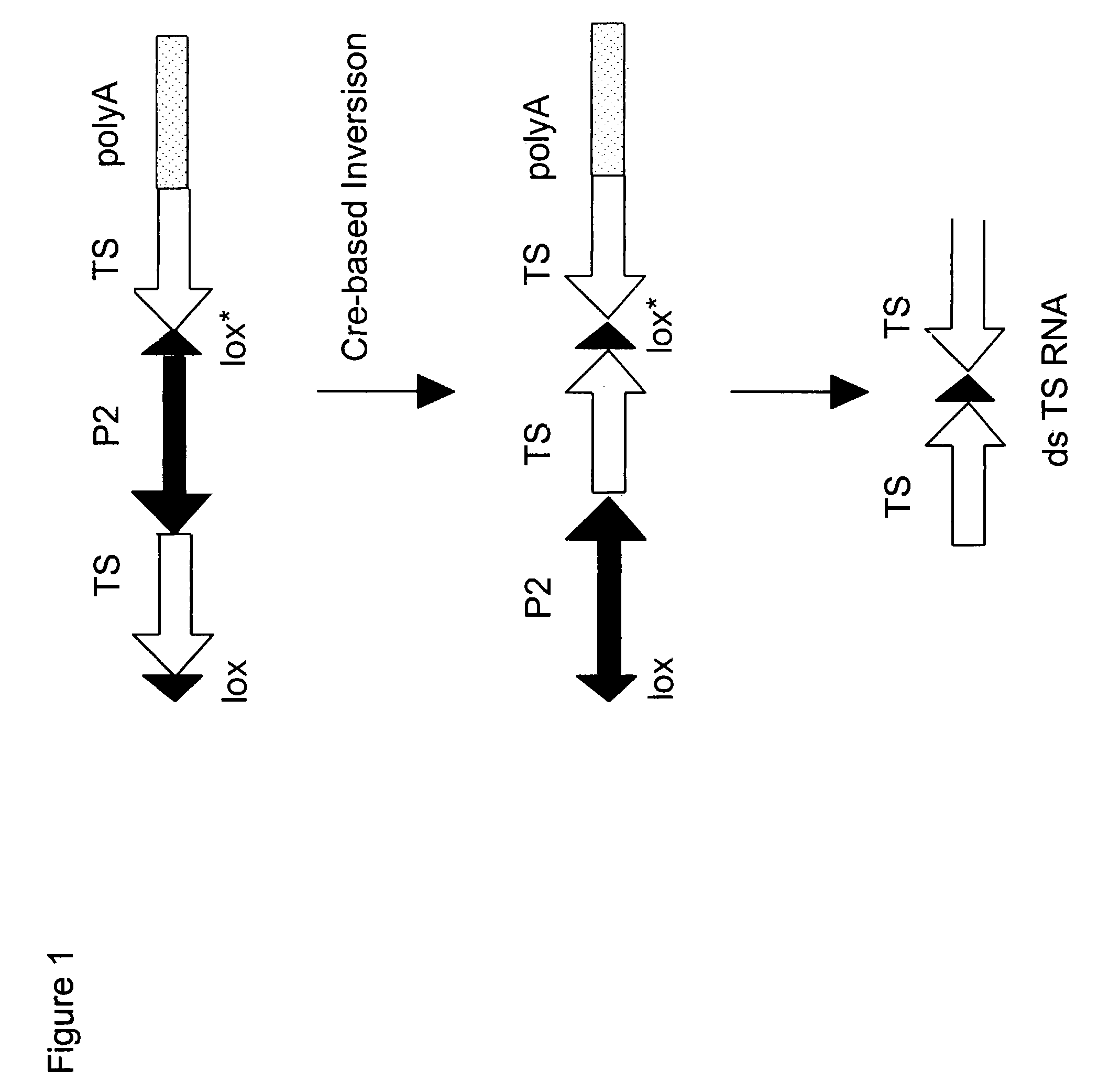Method of controlling gene silencing using site specific recombination
a site-specific recombination and gene silencing technology, applied in the field of molecular biology and the genetic transformation of organisms, can solve the problems of limited solutions, inability to obtain experimental evidence for this hypothesis, and inability to express pi/hc-pro sequence, so as to improve the expression of desirable genes, delay the spread of the virus through the plant, and the effect of severe symptoms
- Summary
- Abstract
- Description
- Claims
- Application Information
AI Technical Summary
Problems solved by technology
Method used
Image
Examples
example 1
Promoter Inversion Construct
[0324]This Example describes the construction of a gene silencing-recombinase construct, having the general structure of lox-P2INV-lox*-TS-P3INV, embodied as LoxP:35S promoter:LoxP: Luc: Actin 2 promoter. This construct corresponds with the schematic shown as FIG. 3.
[0325]Specifically, a promoter inversion construct was made in which the TS (i.e., Luc) is flanked by two promoters (i.e., 35S and Actin 2). Of these two promoters, the 35S promoter is flanked by Lox P sites, such that its orientation is changed by SSR from being divergent with respect to the other promoter (inactive silencing construct) to being convergent (active silencing construct).
[0326]A LoxP:35S promoter:LoxP: Luc: Actin 2 promoter (complement) was made by PCR as follows: Plasmid pGV751 (WO 00 / 17365A2), which contains 35S promoter:Lox P:blocking fragment:Lox P: firefly luciferase:3′ ocs, was used as the DNA template for PCR products 1 and 2. A 1025 bp PCR product 1 containing the 35S pr...
example 2
Promoter Plus Target Sequence Inversion Construct
[0344]This Example describes the construction of an active gene silencing-recombinase construct, having the general structure of lox-P2-TS-5′ intron-lox*-3′ intron-TSINV-polyA, embodied as LoxP:35S promoter: Luc ORF:5′ intron:LoxP*:3′ intron:Luc ORFINV: 3′ OCS UTR. This construct corresponds with the schematic shown as FIG. 2. Synthesis of the active silencing construct occurred as follows:
[0345]A 991 bp PCR product 6 containing the 35S promoter was made by using SEQ ID NO: 1 (P314 upper primer) and SEQ ID NO: 8 (P320 lower primer) on plasmid pGV751 DNA template [WO 00 / 1 7365A2, described in Example 1]. A 968 bp Hind III-Bam HI fragment from PCR product 6 was cloned into pSK+ (Stratagene) to result in plasmid pGV957.
[0346]A 748 bp PCR product 7 containing a 3′ ocs was made by using SEQ ID NO: 3 (P316 upper primer) and SEQ ID NO: 13 (P321 lower primer) on plasmid pGV751 DNA template. A 726 bp Xba I-Sac I fragment from PCR product 7 was...
PUM
| Property | Measurement | Unit |
|---|---|---|
| volume | aaaaa | aaaaa |
| volume | aaaaa | aaaaa |
| volume | aaaaa | aaaaa |
Abstract
Description
Claims
Application Information
 Login to View More
Login to View More - R&D
- Intellectual Property
- Life Sciences
- Materials
- Tech Scout
- Unparalleled Data Quality
- Higher Quality Content
- 60% Fewer Hallucinations
Browse by: Latest US Patents, China's latest patents, Technical Efficacy Thesaurus, Application Domain, Technology Topic, Popular Technical Reports.
© 2025 PatSnap. All rights reserved.Legal|Privacy policy|Modern Slavery Act Transparency Statement|Sitemap|About US| Contact US: help@patsnap.com



